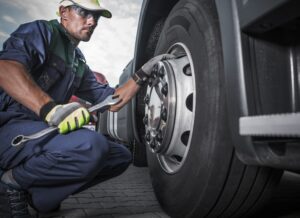 The Commercial Vehicle Safety Alliance (CVSA) and the Federal Motor Carrier Safety Administration (FMCSA) work together to ensure consistent commercial vehicle safety standards across the United States. These federal tire regulations protect truck drivers and other motorists on the road.
The Commercial Vehicle Safety Alliance (CVSA) and the Federal Motor Carrier Safety Administration (FMCSA) work together to ensure consistent commercial vehicle safety standards across the United States. These federal tire regulations protect truck drivers and other motorists on the road.
Commercial truck tires endure extensive wear from long hours on the road, harsh weather, and varied terrain conditions. To prevent tire-related accidents, the FMCSA enforces specific regulations for tire inspections, load ratings, and maintenance records.
Federal standards require commercial trucks to maintain a front tire tread depth of 4/32 inches, while all other tires must have at least 2/32 inches of tread. These requirements are outlined in FMCSA Title 49.
State regulations can vary, particularly regarding tire chain requirements in winter, tread depth requirements for mountain driving, retreading restrictions, and weight limits that affect tire loading.
DOT inspections look for specific tire problems: no exposed internal materials, no tread separation, no cuts that expose the tire interior, and no bulging. Tire pressure must meet manufacturer specifications, and tires on the same axle must be identical.
Carriers must ensure their staff receives up-to-date training on tire maintenance procedures. Only qualified technicians should perform repairs, and they must document all work, including repair date, type, tire serial number, and technician identification.
The DOT estimates that commercial vehicle tires typically lose 1/32 inch of tread for every 10,000 miles driven. Signs of dangerous wear include uneven patterns, worn edges, flat spots from sudden braking, and center wear from improper inflation.
Weather significantly impacts tire conditions through heat damage, pressure changes in cold weather, cracking, hydroplaning wear, and UV exposure. Regular rotation, proper inflation, and scheduled maintenance help ensure compliance with safety standards.

They must immediately report any tire defects or safety concerns to their carrier and refuse to operate vehicles with unsafe tire conditions. Understanding load ratings and adjusting tire pressure based on cargo weight falls under driver responsibility, as does monitoring tire performance during extreme weather conditions.
Both manufacturers and drivers can be held responsible for tire-related accidents. Companies must maintain detailed tire maintenance records for at least one year, including inspections, repairs, and replacements.
Violations can result in civil lawsuits, criminal charges in cases of falsified records leading to deaths, FMCSA fines, lower Safety Measurement Scores, and increased insurance costs.
Tire blowouts often cause devastating multi-vehicle accidents. When large trucks lose control, they can severely damage smaller vehicles, leading to serious injuries like broken bones, spinal damage, brain trauma, or death.
Truck drivers must follow specific safety protocols when a tire fails during operation. Drivers should:
Continuing to drive on a failed tire can cause extensive vehicle damage and create hazardous conditions for other motorists.
Daily inspections must include pressure monitoring and comprehensive tire checks. Modern monitoring systems help maintain tire integrity, while proper attention to temperature and load ratings ensures safe operation.
If you’ve suffered injuries from a truck accident caused by defective or poorly maintained tires, talk to an attorney. Truck accident cases involve many parties from trucking companies to maintenance crews to manufacturers, and federal trucking rules take specialized knowledge. A truck accident attorney can investigate maintenance records, identify violations, and hold negligent parties accountable while you focus on recovery. Contact a qualified truck accident attorney at Regan Zambri Long today to protect your rights and pursue the compensation you deserve.